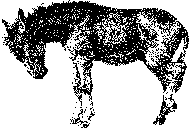
Irish speakers once referred to Palm Sunday as Domhnach an Iúir - Yew Sunday. That's because the "palm" was most often a sprig from the yew tree or some other conifer such as a silver fir, spruce or cypress. In County Fermanagh, early on every Palm Sunday morning, a Protestant cut down sprigs of yew and placed them on his garden wall.
In the old days, families brought their own fronds of "palm" to the church to be blessed. While he didn't have a Palm Sunday ceremony in his own church, it's on record that this very considerate Protestant soul offered palms to his less than fortunate Catholic neighbors on their way to chapel.
It was expected that every member of a family would be present at Mass to receive a blessed palm in commemoration of Christ's entry into Jerusalem. After Mass, the men and boys broke off a sprig and wore it all day in their hat or lapel. Often, it was worn for much longer.
In Spencer T. Hall's Life and Death in Ireland, he writes: "...most of the men and boys I met had small bunches of palm in their hats or buttonholes (lapels), which they said had been consecrated by the priest, and which many of them wore or renewed for a nearly a fortnight afterwards." In this context, we are assuming that the author is implying that renewal meant more blessings - perhaps on Good Friday, Easter and beyond.
As for the womenfolk and children, they brought their fronds home. A palm would be hung up in the house; one would be put out in the barn so that the animals could share in the blessing. And another would be set aside to be used as a sprinkler for Holy Water.
In many areas of Ireland, a palm stem was charred and a cross was marked on eggs set for hatching, while in parts of Galway and Mayo, a bit of palm was shredded and mixed through the seed grain. In any event, most families had extra eggs on hand because of the Lenten fast, so Palm Sunday was often the day that children called on neighbors and began collecting eggs for Easter.
The date on which Palm Sunday fell was also closely observed. If it coincided with St. Patrick's Day, when "the Shamrock and Palm would be worn together", it was said that something unusual would occur. This could be interpreted as ominous. The optimistics predicted an exceptionally fine summer or an end to Ireland's troubles. They also made the same predictions when Palm Sunday fell on the feast of the Annunciation - March 25th.
We did a bit of digging. In 1347, Palm Sunday coincided with the feast of the Annunciation. That year, the black death arrived in Messina. By New Year's Eve, it had spread to Genoa. Within three years it had wiped out one third of Europe. On a happier note, in 1945, the Annunciation and Palm Sunday coincided and the war in Europe came to an end. We found two other recent dates: St. Patrick's Day and Palm Sunday coincided in 1940: the Annunciation and Palm Sunday coincided in 1956. We'll be delving into the history books a bit further to see, in retrospect, if these old Irish predictions hold any water.
For future reference: The next time the Annunciation and Palm Sunday coincide is 2018. As for St. Patrick's Day - it won't happen again until 2391. God willing, by then, the troubles will be as ancient history as the pyramids.
http://www.irishcultureandcustoms.com/ACalend/PalmSunday.html







No comments:
Post a Comment